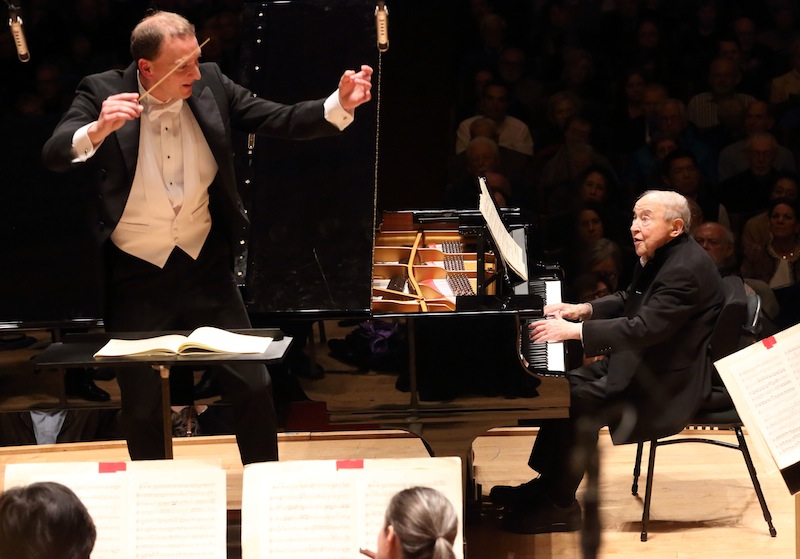Gnann makes admirable BSO debut with Dvořák and Mozart

Menahem Pressler performed Mozart’s Piano Concerto No. 27 with Moritz Gnann and the BSO Tuesday night. Photo: Hilary Scott
In 1893, Antonín Dvořák, then living in the United States, laid out a plan for how American composers should go about writing in a unique idiom. Drawing upon the popular appeal of Theodore Baker’s studies of Native American Music, Buffalo Bill Cody’s Wild West Shows, and the singing of Harry T. Burleigh, Dvořák urged composers to employ African-American spirituals and Native American rhythms. The composer set out to test his prescription by writing a number of “American” works. His Symphony No. 9 in E minor, subtitled From the New World, stands as his most famous example.
The reaction was mixed. The loudest complaint came from Amy Beach, who argued that Dvořák’s ethnic sources were no more authentic than her own experience. The symphony even drew commentary half a century later when Leonard Bernstein critiqued the work for sounding more old-world than new.
The symphony has remained popular for many other reasons. One of them, surely, is its capacity, as in any great work, to bring rich experiences the more it is studied and performed. Tuesday night at Symphony Hall, it provided the main course in a concert by the Boston Symphony Orchestra. BSO assistant conductor Moritz Gnann, who made his subscription debut, led the way.
The symphony is rife with drama, a trait perhaps owed to the fact that it contains music Dvořák intended for a large-scale piece based on Longfellow’s Song of Hiawatha, which never materialized.
The second movement, famous in its second life as the hymn “Going Home,” depicts a vast prairie and Hiawatha’s return from the hunt. The inner section of the scherzo is a vibrant wedding celebration, and the finale, as suggested by Dvořák scholar Michael Beckerman, is a tone poem that tells of Hiawatha’s vengeful pursuit of Pau-Puk-Keewis.
Gnann led a reading that was remarkable for its rhythmic precision. The conductor is not a dramatic presence on the podium, but after weeks of witnessing Andris Nelsons oversee every detail in the Brahms symphonies and piano concertos, it was a bit refreshing to watch a conductor step back and let the music speak for itself.
Not that Gnann worked on autopilot. He led in broad strokes through gentle waving gestures and the occasional brisk movement that drew playing of intensity. That said, Tuesday’s performance of the New World Symphony could have used more drama, particularly in the string passages of the introduction and scherzo.
But there were plenty of lyrical moments. The phrases of the second movement were beautifully sculpted, with solo English horn providing phrases of tender delicacy. Gnann shaped the “Swing Low, Sweet Chariot” theme of the first movement in a singing arc.
The BSO brass had a stellar night save for an unfortunate horn crack in the main theme of the first movement. The musicians provided sturdy walls of sound in the finale’s dark recurring fanfare.
The opener was Mendelssohn’s The Hebrides, and Gnann led a colorful reading. The melodies of this overture had a cold, haunting mystery. Bugle call figures sounded through the waving texture like beacons in the mist. The BSO woodwinds were especially fine, with clarinets and flutes supplying soft commentary to the string phrases.
The concert’s first half was dedicated to Mozart’s Piano Concerto No. 27. The soloist was Menahem Pressler, who still enjoys a busy career at the age of 92.
Walking with a cane, Pressler had to be helped to his seat, but his presence at the keyboard, given his tasteful playing, beamed with the vitality of a musician one-third his age.
Pressler is a consummate Mozartean who rendered the passages of the composer’s final piano concerto with ringing tone and clarity. This concerto, which looks back to simple classicism and ahead to romanticism at the same time, requires a fine touch, and Pressler coaxed lines of silver from his instrument.
In solo passages, as in the opening of the second movement and inner sections of the third, the pianist took time to explore the phrasing, shaping the lines with light rubato. His cadenzas, Mozart’s originals, had an understated drama. Cascading figures took him all over the keyboard and chords in the left hand added just the right amount of depth to the sound.
Gnann and Pressler shared a sensitive view of the piece, and the two worked together to bring off the work’s many singing lines. The orchestra responded with elegant accompaniment.
Warm applause brought Pressler back to the keyboard for a searching encore, Chopin’s Nocturne No. 20 in C-sharp minor, Op. posth.
The program will be repeated 1:30 p.m. Friday and 8 p.m. Saturday at Symphony Hall. bso.org; 888-266-1200.
Posted in Performances



